Dakota Coteau Field Site NEON (DCFS) Soil Descriptions
Distributed Soils Reports
Pedon Descriptions
Pit‐level observations and field measurements reported using the standard NRCS format. They contain volume estimates for coarse fragments > 20 mm where applicable.
Site Level Plot Summary
A narrative summary that places the sampled soil pedons in the broader context of soils and geomorphology for the entire NEON site.
Megapit Images
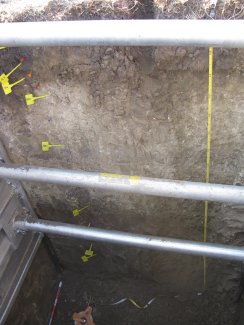
D09 DCFS megapit soil profile 0-200 cm
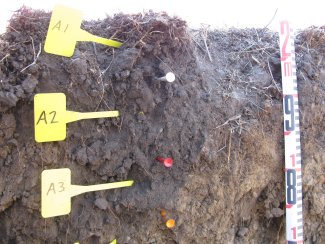
D09 DCFS megapit soil profile 0-30 cm
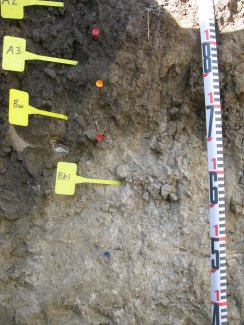
D09 DCFS megapit soil profile 13-63 cm
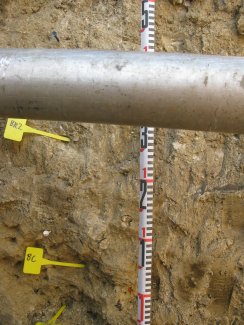
D09 DCFS megapit soil profile 50-105 cm
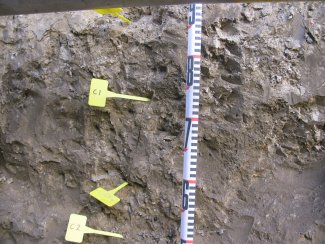
D09 DCFS megapit soil profile 102-150 cm
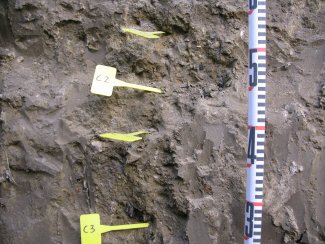
D09 DCFS megapit soil profile 144-175 cm
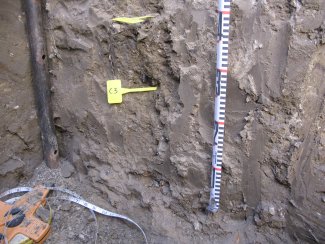
D09 DCFS megapit soil profile 158-200 cm
Megapit Pedon Descriptions
| Print Date | Jul 22 2015 |
|---|---|
| Description Date | Sep 26 2012 |
| Describer | Lance Duey |
| Site ID | 12ND093002 |
| Pedon ID | S2012ND093002 |
| Lab Source ID | KSSL |
| Lab Pedon # | 13N0001 |
| Soil Name as Described/Sampled | Max |
| Taxon Kind | series |
| Geomorphic Setting | on backslope of till plain |
| Upslope Shape | linear |
| Cross Slope Shape | linear |
| Particle Size Control Section | 25 to 100 cm. |
| Description origin | Pedon PC 5.0 |
| State | North Dakota |
| County | Stutsman |
| MLRA | 53B -- Central Dark Brown Glaciated Plains |
| Std Latitude | 47.1591900 |
| Std Longitude | -99.1125100 |
| Primary Earth Cover | Grass/herbaceous cover |
| Secondary Earth Cover | Grassland rangeland |
| Parent Material | fine loamy glacial till |
| Description database | KSSL |
| Diagnostic Features | mollic epipedon 0 to 26 cm. cambic horizon 26 to 35 cm. |
| Slope (%) | 8.0 |
| Aspect (deg) | 70 |
| Drainage Class | well |
| Horizon Details |
A1--0 to 8 centimeters (0.0 to 3.1 inches); black (10YR 2/1) loam, very dark grayish brown (2.5Y 3/2), dry; 23 percent clay; strong coarse granular structure; mixed rock fragments; noneffervescent; clear smooth boundary. Lab sample # 13N00001 A2--8 to 18 centimeters (3.1 to 7.1 inches); black (10YR 2/1) loam, very dark grayish brown (2.5Y 3/2), dry; 23 percent clay; moderate fine subangular blocky structure; 1 percent 5 to 20-millimeter mixed rock fragments; noneffervescent; clear smooth boundary. Lab sample # 13N00002 A3--18 to 26 centimeters (7.1 to 10.2 inches); very dark grayish brown (10YR 3/2) loam, dark grayish brown (2.5Y 4/2), dry; 23 percent clay; weak fine subangular blocky structure; and ; 1 percent mixed rock fragments; noneffervescent; gradual smooth boundary. Lab sample # 13N00003 Bw--26 to 35 centimeters (10.2 to 13.8 inches); brown (10YR 4/3) clay loam, light olive brown (2.5Y 5/3), dry; 28 percent clay; moderate medium prismatic, and moderate medium subangular blocky structure; noneffervescent; gradual irregular boundary. Lab sample # 13N00004 Bk1--35 to 55 centimeters (13.8 to 21.7 inches); light olive brown (2.5Y 5/3) loam, light olive brown (2.5Y 5/4), dry; 26 percent clay; moderate coarse prismatic, and moderate medium subangular blocky structure; 15 percent medium threadlike 10YR 6/1) carbonate masses throughout; very slight effervescence; gradual wavy boundary. Lab sample # 13N00005 Bk2--55 to 92 centimeters (21.7 to 36.2 inches); light olive brown (2.5Y 5/4) fine sandy loam, light yellowish brown (2.5Y 6/4), dry; 25 percent clay; weak medium prismatic, and weak fine subangular blocky structure; 6 percent coarse threadlike 2.5Y 6/1) carbonate masses throughout and 6 percent medium threadlike 2.5Y 6/1) carbonate masses throughout; very slight effervescence; gradual wavy boundary. Lab sample # 13N00006 BC--92 to 110 centimeters (36.2 to 43.3 inches); light olive brown (2.5Y 5/3) loam, light yellowish brown (2.5Y 6/4), dry; 20 percent clay; moderate very coarse prismatic, and moderate medium subangular blocky structure; 3 percent fine 10YR 5/1) masses of reduced iron throughout and 3 percent medium 10YR 5/1) masses of reduced iron throughout and 5 percent medium 2.5Y 4/6) masses of oxidized iron throughout; 7 percent medium threadlike 10YR 6/1) carbonate masses throughout; very slight effervescence; gradual wavy boundary. Lab sample # 13N00007 C1--110 to 148 centimeters (43.3 to 58.3 inches); olive brown (2.5Y 4/4) loam, light olive brown (2.5Y 5/3), dry; 24 percent clay; moderate very coarse prismatic, and moderate medium subangular blocky structure; 3 percent fine 2.5Y 4/6) masses of oxidized iron throughout and 3 percent medium 2.5Y 4/6) masses of oxidized iron throughout and 5 percent fine 10YR 5/1) masses of reduced iron throughout and 5 percent medium 10YR 5/1) masses of reduced iron throughout; 4 percent medium threadlike 10YR 6/1) carbonate masses throughout; strong effervescence; gradual wavy boundary. Lab sample # 13N00008 C2--148 to 165 centimeters (58.3 to 65.0 inches); olive brown (2.5Y 4/3) loam, light yellowish brown (2.5Y 6/4), dry; 24 percent clay; moderate medium prismatic, and moderate fine subangular blocky structure; 2 percent fine 10YR 4/6) masses of oxidized iron; 2 percent medium threadlike 10YR 6/1) carbonate masses throughout; strong effervescence; gradual wavy boundary. Lab sample # 13N00009 C3--165 to 200 centimeters (65.0 to 78.7 inches); olive brown (2.5Y 4/4) clay loam, light olive brown (2.5Y 5/3), dry; 24 percent clay; massive; 4 percent 2.5Y 5/1) masses of reduced iron throughout and 4 percent 10YR 2/1) manganese masses throughout and 6 percent 10YR 4/6) masses of oxidized iron throughout; 1 percent medium threadlike 10YR 6/1) carbonate masses throughout; slight effervescence; gradual wavy boundary. Lab sample # 13N00010 |
Credits: This megapit soil pedon description was generously created by USDA Natural Resource Conservation Service staff, with particular thanks to Larry West, Jon Hempel, and numerous field staff.